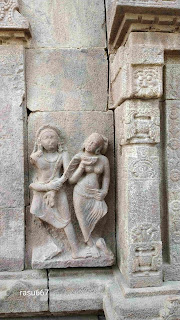NAVA BRAHMA TEMPLES
Brahmeshwara is the consort of Jogulamba. The Nava Brahma temples are nine temples of Lord Shiva spread around the Jogulamba Temple. These temples are constructed by the Badami Chalukyas starting from 7th century CE. The Badami Chalikyas were great patrons of art and these nine temples have lovely sculpture on it. Sadly many parts of the sculpture was destroyed by the Muslim invaders.
1. BALA BRAHMA TEMPLE
This temple is completely ruined. All sculpture has been destroyed.
Dwarapalakas on either side of the door. One is so badly damaged.
This temple, atleast parts of the sculpture were visible.
Through the destruction, you cannot fail to appreciate the sculpture.
Brahmeshwara is the consort of Jogulamba. The Nava Brahma temples are nine temples of Lord Shiva spread around the Jogulamba Temple. These temples are constructed by the Badami Chalukyas starting from 7th century CE. The Badami Chalikyas were great patrons of art and these nine temples have lovely sculpture on it. Sadly many parts of the sculpture was destroyed by the Muslim invaders.
1. BALA BRAHMA TEMPLE
Pillared corridor
It is in this temple that the broken idol of Jogulamba was safeguarded from the invaders. This temple was built in 702 CE. Regular temple rituals are performed here and Shivaratri is celebrated every year.
2. SWARGA BRAHMA TEMPLE
Built during 681-696 CE in the Vinayaditya era, it is the most elaborately sculpted temple.
On the left is Bhikshatana murty, center is Indra with Iravat, right is Nataraj
Naga and floral design on the ceiling inside
Kirthimukha and kalash
Tripurantaka on left, Aditya in center and Lingodbhava murty on right
Ardanareeshwara, badly mutilated. The female part has been mutilated
affectionate couple
Lakulisa in center
Gandarvas floating above
Nataraja destroyed. Just notice the multi layered carving. Even through the destruction, we can see the glory of the carving.
Trivikrama
courtship
One side of the temple
3. PADMA BRAHMA TEMPLE
Probably the last to be built, it is unfinished in terms of work on the temple.
4. GARUDA BRAHMA TEMPLE
Built between 848-891 CE during the time of Vijayaditya.
The niches are empty, murtis may have been destroyed here.
Garuda above the Garbagriha doorway
Dwarapalaka
5. KUMARA BRAHMA TEMPLE
This temple was probably built during the time of Vikramaditya, 655-681 CE. The outer walls dont have much carving but the pillars in front are carved.
Pillars with carving outside
Mayuras and floral designs on the inner pillars
6. ARKA BRAHMA TEMPLE
7. VEERA BRAHMA TEMPLE
On the vimana we can see a Nataraja sculpture. This temple also has been badly damaged.
A naga on the ceiling inside. These nagas were sculpted in a couple of temples along with the floral carving.
A beheaded Nandi.
8.VISHWA BRAHMA TEMPLE
Through the destruction, you cannot fail to appreciate the sculpture.
Sculpture and destruction too
It makes me so sad seeing the destruction.
ASI Museum
The ASI museum is right beside these temples. Though it is small, it has some wonderful pieces salvaged from the ruins and displayed.
Ceiling panel, Nataraja with Astadikpalas
The first picture is of Lord Shiva as Pashupati, the Lord of animals.
The third picture is of Shiva, Parvati with Nandi being worshipped.
Fourth depicts the story where Mahadev comes as a tribal hunter killing the boar, that Arjuna was chasing, to teach humility to Arjuna.
Lower half is the story of Trivikrama
Upper half is Shiva slaying Gajasura, lower half is Narsimha Deva slaying Hiranyakashipu.
9. TARAKA BRAHMA TEMPLE
Badly ruined Taraka Brahma Temple.
Ancient inscription.
When you cannot make something, you have no right to destroy it. That is what i believe strongly.
Thus ended my Nava Brahma temples visit. Beautiful but heart breaking too.






























































